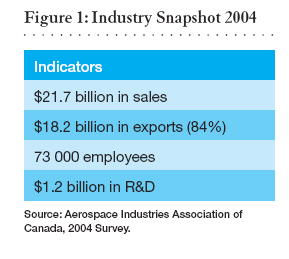Over many years, Canada has developed into one of the world's major aerospace and defence nations. This success is a product of private sector dynamism and public sector policies. Yet, current success is no guarantee of future performance. The global aerospace and defence sector is shifting dramatically. To sustain Canada's position, industry and government must consider the new realities and must develop a renewed framework for collaboration – a new national strategic framework for Canada's aerospace and defence industries.
This framework identifies the forces facing the industry, specific actions and strategic choices. For government, it will guide future policy and program decisions, and presents a basis for collaboration with other stakeholders. The Framework is national in scope, inclusive of key stakeholders and supportive of public policy perspectives. It looks out over a 20-year time horizon, proposing a vision to the year 2025. It examines 1 both short-term and long-term issues with the ultimate goal of enhancing and sustaining the competitiveness and capabilities of the Canadian aerospace and defence sector.

1 Data on sales, international trade, employment and gross domestic product (GDP) are from Statistics Canada, unless otherwise specified. The industry data are based on the sectors covered by the Aerospace Product and Parts Manufacturing Industry category (3364) under the North American Industry Classification System (NAICS). This classification includes establishments whose main activity is the manufacture of aircraft, missiles and spacecraft, as well as their engines, propulsion systems, auxiliary equipment and parts in general. The in-factory overhaul and conversion of aircraft and their propulsion systems are considered part of this sector. Not included in the NAICS 3364 classification is the manufacture of aircraft instruments, such as navigation, measurement and command systems.
